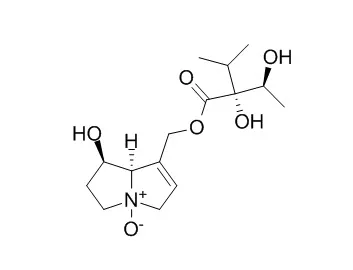| Am J Clin Oncol. 1992 Apr;15(2):135-40. |
| Phase II trial of indicine N-oxide in relapsed acute leukemia of childhood. A report from the Childrens Cancer Study Group.[Pubmed: 1553901] |
METHODS AND RESULTS:
We treated 31 children with acute lymphoblastic leukemia (ALL), 14 children with acute nonlymphoblastic leukemia (ANLL) in relapse, and 1 child with chronic myelogenous leukemia (CML) in blast crisis (CALLA negative) with Indicine N-oxide in a Phase II study. The efficacy and toxicity of the drug were assessed at two dose levels: 2,000 mg/m2/day for 5 consecutive days (14 patients) and 2,500 mg/m2/day for 5 consecutive days (17 patients). One patient with ALL at each dose level achieved a complete response (CR) lasting 6 months and 1 month, respectively. The patient with CML achieved a partial response lasting 4 months. None of the patients with ANLL achieved a CR. Hepatotoxicity was mild (grade 1 or 2) in 63% and moderate (grade 3) in 9% of mild (grade 1 or 2) in 63% and moderate (grade 3) in 9% of patients; 3 patients (9%) experienced severe hepatotoxicity.
CONCLUSIONS:
Although Indicine N-oxide has some antileukemic activity in ALL and is safe at the doses used in this study, the antileukemic activity is significantly less at these two doses than at greater than or equal to 3,000 mg/m2/days for 5 consecutive days. Unfortunately, when the higher doses are administered to children, they are associated with an unacceptably high incidence of severe, irreversible hepatotoxicity. |
| Cancer. 1983 Jul 1;52(1):61-3. |
| Hepatic failure secondary to indicine N-oxide toxicity. A Pediatric Oncology Group Study.[Pubmed: 6573942] |
METHODS AND RESULTS:
Indicine N-oxide, a pyrrolizidine alkaloid, was given to a five-year-old boy with refractory acute myelocytic leukemia. Three days after receiving the drug the patient developed signs and symptoms of acute hepatic failure. The patient died nine days after receiving the drug and an autopsy showed massive hepatic necrosis.
CONCLUSIONS:
The acute hepatic failure observed in this patient may have been secondary to Indicine N-oxide toxicity. |
| Cancer Chemother Pharmacol. 1982 Dec;10(1):43-6. |
| Pharmacokinetic study of indicine N-oxide in pediatric cancer patients.[Pubmed: 7160044] |
METHODS AND RESULTS:
Pharmacokinetics of the experimental antitumor agent Indicine N-oxide were investigated in a group of 23 pediatric cancer patients. Plasma elimination of Indicine N-oxide was best described by a two-compartment open model. The mean plasma distribution phase half-life, plasma elimination phase half-life, and plasma clearance were 8 min, 84 min, and 62 ml/min/m2 (2.1 ml/min/kg), respectively. One patient with renal impairment had an abnormally long plasma elimination phase half-life (275 min) and reduced plasma clearance (17 ml/min/m2). Plasma elimination phase half-life values increased and plasma clearance values decreased with increasing age of the pediatric patients.
CONCLUSIONS:
Plasma elimination of Indicine N-oxide was more rapid in this group of children than in adults who had previously received the drug. |
| Cancer Chemother Pharmacol. 1990;26(5):377-9. |
| Phase I trial of indicine-N-oxide in children with leukemia and solid tumors: a Pediatric Oncology Group study.[Pubmed: 2208580] |
A phase I trial of indicine-N-oxide was carried out in 12 children with solid tumors and in 16 with leukemia.
METHODS AND RESULTS:
Doses of 5, 6, and 7.5 g/m2 were given parenterally as a 15-min infusion every 3 weeks. The maximum tolerated dose in patients with solid tumors was 7.5 g/m2 and the dose-limiting toxicity was myelosuppression. In leukemia, the maximum tolerated dose was 6.0 g/m2 and hepatotoxicity was dose-limiting. Half of the children with leukemia showed elevations in transaminase levels and one child died of massive hepatic necrosis.
CONCLUSIONS:
This hepatotoxicity limits the use of indicine-N-oxide in children with leukemia. Antineoplastic activity was limited to a transient reduction in the numbers of circulating leukemic cells. |






 Cell. 2018 Jan 11;172(1-2):249-261.e12. doi: 10.1016/j.cell.2017.12.019.IF=36.216(2019)
Cell. 2018 Jan 11;172(1-2):249-261.e12. doi: 10.1016/j.cell.2017.12.019.IF=36.216(2019) Cell Metab. 2020 Mar 3;31(3):534-548.e5. doi: 10.1016/j.cmet.2020.01.002.IF=22.415(2019)
Cell Metab. 2020 Mar 3;31(3):534-548.e5. doi: 10.1016/j.cmet.2020.01.002.IF=22.415(2019) Mol Cell. 2017 Nov 16;68(4):673-685.e6. doi: 10.1016/j.molcel.2017.10.022.IF=14.548(2019)
Mol Cell. 2017 Nov 16;68(4):673-685.e6. doi: 10.1016/j.molcel.2017.10.022.IF=14.548(2019)